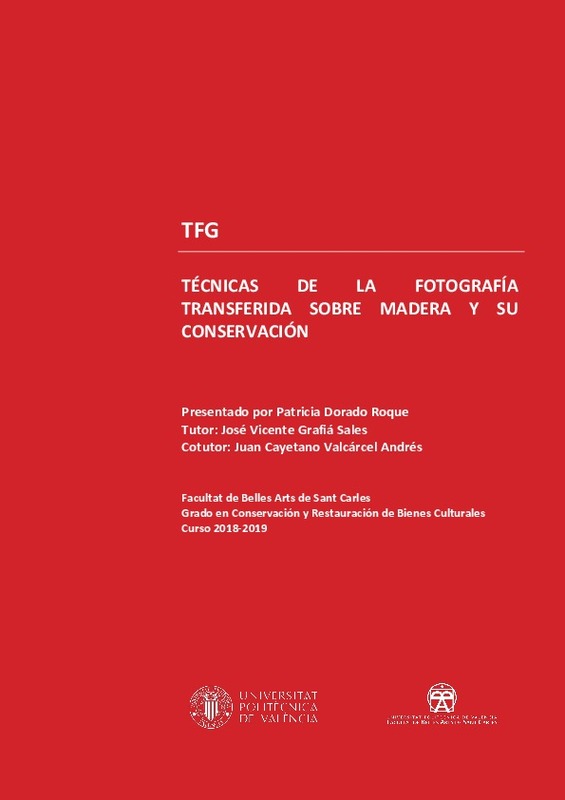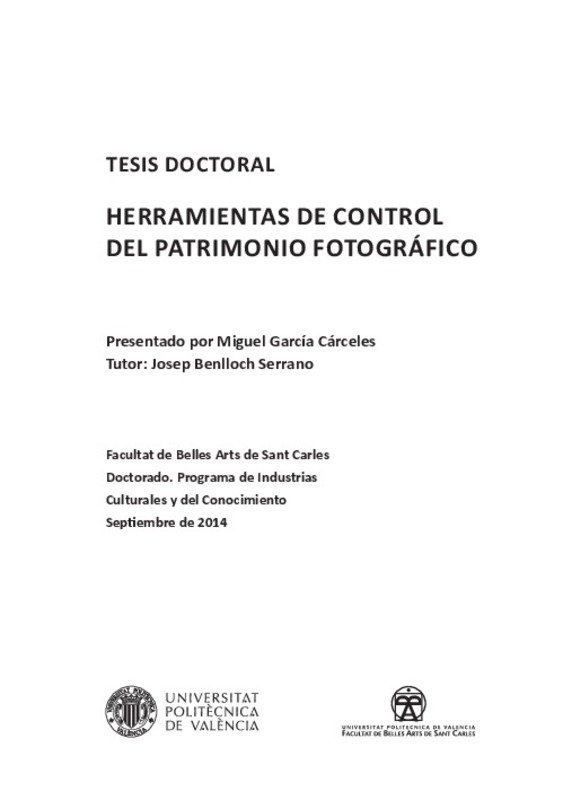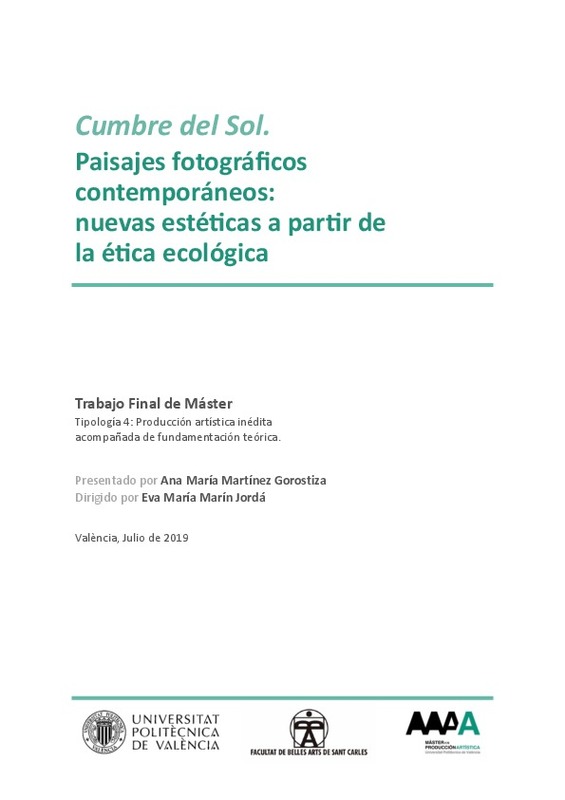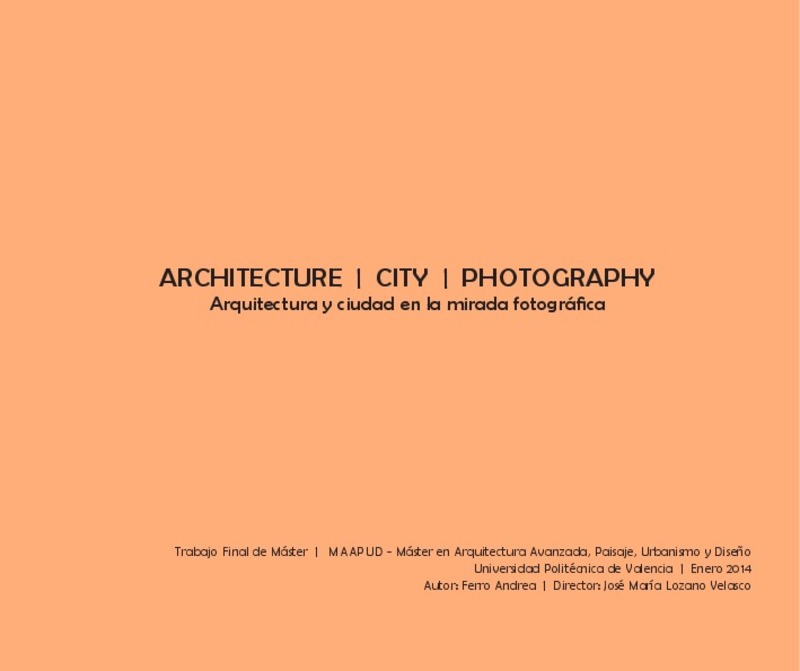|
Resumen:
|
Este trabajo pretende abordar diversas técnicas de la fotografía transferida sobre
madera, así como ejemplos de artistas que la emplean y toda su posible
conservación.
La fotografía transferida sobre madera nace de la ...[+]
Este trabajo pretende abordar diversas técnicas de la fotografía transferida sobre
madera, así como ejemplos de artistas que la emplean y toda su posible
conservación.
La fotografía transferida sobre madera nace de la mano de Rauschenberg sobre
el año 1952, en plena época del Neo-Dadá y el Pop Art, aunque no fue hasta el
año 1958 cuando perfeccionó dicha técnica. En sus inicios, únicamente transfería
imágenes obtenidas gracias a los medios de comunicación, durante un viaje a
Cuba, como son las fotografías de periódico, generalmente en papel, y
posteriormente de otros materiales.
Una de las variantes artísticas donde se ha utilizado mucho esta técnica de
transferir imágenes sobre madera (u otros soportes) es el conocido fotomontaje.
El fotomontaje según la Real Academia Española es «una composición fotográfica
en que se utilizan fotografías con intención artística, publicitaria, etc.». Fue
utilizada también desde su origen como forma política, tras la Primera Guerra
Mundial por los dadaístas en Alemania, como Raoul Hausmann, quien lo utilizó
como "Anarquía Visual" (visueller anarchie).
También fue empleada por artistas surrealistas como Man Ray, René Magritte.
Esta técnica, como su propio nombre indica, permite trasladar la imagen de una
superficie o soporte a otro totalmente distinto, existiendo hoy en día dos
principales procedimientos. Por una parte es posible realizarla mediante
disolventes, como son los disolventes universales, el benzol o la acetona, y por
otra parte utilizando procedimientos tanto fotomecánicos como serigráficos, desde
los años 70 hasta la actualidad.
Para realizar esta técnica se puede utilizar cualquier documento impreso con una
impresora láser, lo cual incluye papeles de prácticamente cualquier gramaje,
periódicos, revistas, fotografías, etc, pero en cambio, no es posible realizarla
mediante impresiones realizadas con impresoras de inyección así como
fotografías tradicionales debido a su particular capa de barniz.
En cuanto a esta técnica dentro de los dos movimientos artísticos como el NeoDadá
y el Pop Art cabe destacar que no todos los artistas la utilizaban de la
misma manera cumpliendo todos los mismos procedimientos, sino que al ser una
técnica nueva en la época comenzaron a innovar buscando en ocasiones la
espontaneidad a la hora de realizarla, resaltando los defectos finales evitando así
la homogeneidad de la transferencia en su totalidad. Esto ocurre por la posibilidad
que ofrece la misma técnica de ser tanto parcial como completa, dependiendo el
resultado final de no solo el disolvente aplicado, sino también de la cantidad
aplicada, así como del tiempo de exposición, etcétera.
Dicho todo esto, es igual de importante hablar de la madera, ya que es el soporte
principal de este tipo de obras, aunque actualmente también lo pueden ser otros
materiales como el vidrio, el metal y la cerámica entre muchos otros.
La madera que mejor acepta esta técnica es la madera porosa, ya que absorbe
sin ningún problema y rápidamente tanto la tinta aplicada mediante un tóner como
el disolvente que ayuda al proceso de la transferencia en sí, lo cual asegura su
éxito y su fijación (que posteriormente suele ser reforzado con un barniz).
En este resumen también se abarcarán estudios para poder determinar y
establecer qué condiciones debe de tener la madera aparte de la porosidad, así
como qué tipo de madera es la más idónea, como maderas de pino, maderas de
chopo, maderas de contrachapado, corchos, etcétera, y a su vez los productos
disolventes como los comerciales universales, geles decapantes o cetonas (sin
olvidar previamente que los productos como el alcohol, el aguarrás o la esencia
de trementina no son efectivos).
Dentro de la conservación preventiva es importante tener en cuenta el barniz, ya
que pese a ser un producto utilizado para asegurar de cierta forma la protección
de la ob
[-]
This work is intended to address various techniques photograph transferred onto
wood, as well as examples of artists who used it and all its possible conservation.
On wood transferred photography born Rauschenberg hand ...[+]
This work is intended to address various techniques photograph transferred onto
wood, as well as examples of artists who used it and all its possible conservation.
On wood transferred photography born Rauschenberg hand over in 1952, at the
height of the work and Pop Art, although it was not until the year 1958 when he
perfected this technique. In the beginning, it only transferred images obtained
thanks to the media, during a trip to Cuba, such as photographs of newspaper,
usually on paper, and subsequently other materials.
One of the artistic variations where has been much used this technique to
transfer images on wood (or other media) is known photomontage.
According to the Real Academia Española photomontage is "a photographic
composition using pictures with intention to artistic, advertising, etc.". It was
used from its origin as a political form, after the first world war by the dadaists in
Germany, as Raoul Hausmann, who used it as "Visual anarchy" (visueller
anarchie).
It was also used by surrealist artists such as Man Ray, René Magritte.
This technique, as its name suggests, allows to move the image of a surface or
medium to another completely different, today there are two main procedures.
On the one hand it is possible to perform using solvents, such as acetone, benzol,
or universal solvent, and on the other hand using photomechanical both
procedures as screen printing, from the 1970s to the present day.
To make this technique can use any document printed with a laser printer, which
includes papers from virtually any weight, newspapers, magazines, photographs,
etc, but on the other hand, it is not possible through impressions made with
inkjet printers as well as traditional photographs due to its particular layer of
varnish.
In terms of this technique within the two artistic movements such as Pop Art and
the work should be noted that not all artists used it in the same way fulfilling all
the same procedures, but to be a new technique at the time began to innovate
looking for spontaneity when it comes to it, sometimes highlighting the final
defects thus avoiding the homogeneity of the transfer in its entirety. This occurs
because of the possibility that it offers the same technique to be either partial or
full, depending on the outcome of not only the applied solvent, but also of the
amount applied, as well as the exposure time, etc.
Having said all that, it is just as important to talk about wood, which is the
mainstay of this type of work, although today other materials such as glass, metal
and ceramics among many can also be others.
Wood that better accept this technique is the porous wood, since it absorbs
quickly without any problem and both applied using a toner ink and solvent
which helps the transfer process itself, which ensures its success and its
attachment (which later It tends to be reinforced with a varnish).
This summary also studies cover in order to determine and establish what
conditions must have the wood apart from the porosity, as well as what type of
wood is the most suitable, as pine woods, poplar wood, wood plywood, corks,
etc, and at the same time solvents products such as universal commercial,
pickling gels or ketones (not to mention previously that products such as alcohol,
turpentine or turpentine essence are not effective).
Within the preventive conservation is important to take into account the varnish,
since despite being a product used to make in a certain way the protection of the
work in its entirety are very frequent in this damage associated with the sunlight
exposure and damage that in turn this produces an oxidation, which can be
observed by its yellowish trail that leaves on the work. Also suffer damage and
damage associated with moisture, which can attract attacks as the
microorganisms, and also the dimensional changes, which may cause across the
surface of the various work dribbles, which leads to losses and lagoons localiz
[-]
|










